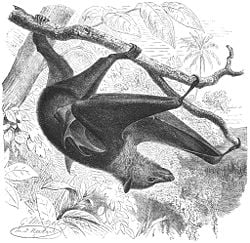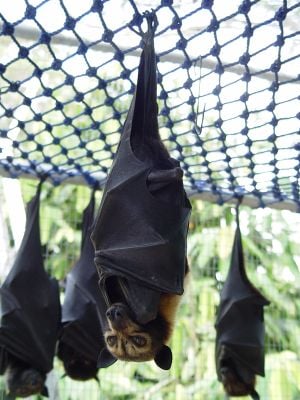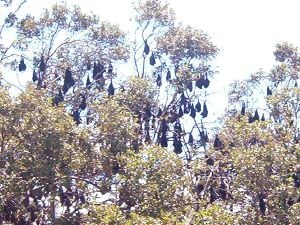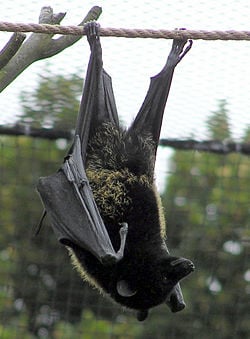Difference between revisions of "Megabat" - New World Encyclopedia
Rick Swarts (talk | contribs) |
Rick Swarts (talk | contribs) |
||
| Line 106: | Line 106: | ||
== References == | == References == | ||
| − | |||
| − | <ref>{{cite web | title=Primitive Early Eocene bat from Wyoming and the evolution of flight and echolocation | doi=10.1038/nature06549 | url= | + | * Eick, G. N., D. S. Jacobs, and C. A. Matthee. 2005. [http://mbe.oxfordjournals.org/cgi/pmidlookup?view=long&pmid=15930153 A nuclear DNA phylogenetic perspective on the evolution of echolocation and historical biogeography of extant bats (Chiroptera)]. ''Molecular Biology and Evolution'' 22(9): 1869–86. PMID 15930153. Retrieved October 18, 2008. |
| + | |||
| + | |||
| + | <ref>{{cite web | title=Primitive Early Eocene bat from Wyoming and the evolution of flight and echolocation | doi=10.1038/nature06549 | url= | accessdate=2008-07-03 | date=[[2008-02-14]] | work=Nature | quote=recent studies unambiguously support bat monophyly}}</ref> | ||
Nature 451, 818-821 (14 February 2008) | doi:10.1038/nature06549; Received 21 September 2007; Accepted 10 December 2007 | Nature 451, 818-821 (14 February 2008) | doi:10.1038/nature06549; Received 21 September 2007; Accepted 10 December 2007 | ||
| − | |||
| − | |||
| − | |||
| − | |||
| − | |||
| − | |||
| − | |||
| + | * Simmons, N. B., K. L. Seymour, J. Habersetzer, and G. F. Gunnell. 2008. [http://www.nature.com/nature/journal/v451/n7180/abs/nature06549.html Primitive Early Eocene bat from Wyoming and the evolution of flight and echolocation]. ''Nature'' 451: 818-821. Retrieved October 18, 2008. | ||
| + | |||
| + | * Adkins, R. M., and R. L. Honeycutt. 1991. [http://www.pnas.org/cgi/reprint/88/22/10317.pdf Molecular phylogeny of the superorder Archonta]. ''Proceedings of the National Academy of Sciences of the U.S.A.'' 88(22): 10317–10321. PMID 1658802. Retrieved October 19, 2008. | ||
| + | |||
| + | |||
| + | * Hutcheon, J. M., and T. Garland. 2004. [http://www.springerlink.com/content/j186577190385878/ Are megabats big?]. ''Journal of Mammalian Evolution'' 11(3-4): 257-277. Retrieved October 18, 2008. | ||
| + | |||
| + | |||
| + | * Wund, M., and P. Myers. 2005. [http://animaldiversity.ummz.umich.edu/site/accounts/information/Chiroptera.html Chiroptera]. ''Animal Diversity Web''. Retrieved October 19, 2008. | ||
| + | |||
| + | |||
| + | |||
| + | * Myers, P. 2001. [http://animaldiversity.ummz.umich.edu/site/accounts/information/Pteropodidae.html Pteropodidae]. ''Animal Diversity Web''. Retrieved October 18, 2008. | ||
| + | |||
| + | |||
| + | |||
| + | |||
| + | The family includes around 166 living species placed in approximately 42 genera. Species of pteropodids can be found in tropical and subtropical regions of Africa, through southern and central Asia to Australia, including the Philippines and a number of Pacific islands. They are especially diverse in southeastern Asia, the Indonesian Archipelago, and Australia. | ||
| − | + | Members of this family are the "flying foxes" and other fruit-eating bats of the Old World. | |
| − | |||
| − | |||
| − | |||
| − | |||
| − | |||
| − | |||
| − | |||
| − | |||
| − | |||
* {{cite journal |last=[[Springer]] |first=M. S. |coauthors=et al |year=2005 |month=28 January |title=A Molecular [[Phylogeny]] for Bats Illuminates [[Biogeography]] and the [[Fossil]] Record |journal=Science |doi=10.1126/science.1105113 |volume=307 |pages=580 |pmid=15681385 }} | * {{cite journal |last=[[Springer]] |first=M. S. |coauthors=et al |year=2005 |month=28 January |title=A Molecular [[Phylogeny]] for Bats Illuminates [[Biogeography]] and the [[Fossil]] Record |journal=Science |doi=10.1126/science.1105113 |volume=307 |pages=580 |pmid=15681385 }} | ||
* [http://www.batworld.org Bat World Sanctuary] | * [http://www.batworld.org Bat World Sanctuary] | ||
| Line 145: | Line 149: | ||
* Wilson, D. E., and D. M. Reeder. 2005. ''Mammal Species of the World,'' 3rd edition. Johns Hopkins University Press. ISBN 0801882214. | * Wilson, D. E., and D. M. Reeder. 2005. ''Mammal Species of the World,'' 3rd edition. Johns Hopkins University Press. ISBN 0801882214. | ||
| + | http://www.bucknell.edu/msw3/browse.asp?s=y&id=13800410 | ||
| + | Rousettus (Boneia) bidens | ||
== External links == | == External links == | ||
Revision as of 15:55, 19 October 2008
| Megabats
| ||||||||||||
|---|---|---|---|---|---|---|---|---|---|---|---|---|
 Large flying fox, Pteropus vampyrus
| ||||||||||||
| Scientific classification | ||||||||||||
| ||||||||||||
|
Macroglossinae |
Megabat is the common name for any of the largely herbivorous Old World bats comprising the suborder Megachiroptera of the order Chiroptera (bats), characterized by true wings and flight (as with all bats), large and prominent eyes, generally claws on the second digits supporting the wings, and an excellent sense of smell. Echolocation is almost unknown among the megabats, while it is prominent in the other major division of bats, the microbats comprising the suborder Microchiroptera.
Extant megabats are placed in one family, Pteropodidae, which has about 170 species. These species are found in Africa, Asia, and Oceania. Megabats primarily feed on fruit, nectar, or pollen. These flying mammals are also referred to as fruit bats, old world fruit bats, or flying foxes, or more specifically as Megachiropteran fruit bats.
pollination
Because of their large size and somewhat "spectral" appearance, fruit bats are sometimes used in horror movies to represent vampires or to otherwise lend an aura of spookiness. In reality, as noted above, the bats of this group are purely herbivorous creatures and pose no direct threat to human beings, baby cows, or ill children.
Overview and description
Bats are flying mammals that comprise the order Chiroptera.
Typically, bats, which comprise the mammalian order Chiroptera, are divided into two distinct groups that generally are given the rank of suborders: Megachiroptera, or megabats, and Microchiroptera, or microbats. These two groups may not represent monophyletic lineages, but taxonomies generally reflect this division (Wund and Myers 2005). The names imply that megabats are larger than microbats, but this is true only in a general sense, as some megabat species are smaller than some microbat species. There are, however, several consistent differences between these two groups.
Among the differences between megabats and microbats is the fact that the later use echolocation, whereas megabats generally do not (except for Rousettus and relatives); microbats lack the claw at the second toe of the forelimb characteristic of all but one of the megabats; and megachiropterans tend to have large prominent eyes, unlike the generally small eyes of the echolocating microbats. Furthermore, the ears of the microbats tend to have large pinnae (external ears) and the ears do not form a closed ring, but the edges are separated from each other at the base of the ear. Megabats also tend to have a diet of fruit, nectar or pollen, only supplementing their diets with a few insects, while most microbats eat insects.
Megabats range in size from species with adults only about 6 centimeters (2.4 inches) long and 13 grams to species that reach 40 centimeters (16 inches) in length, attain a wingspan of 150 centimeters (5 feet), and weigh nearly 1 kilogram (more than 2 pounds). The large eyes of most fruit bats allow them to orient visually in the twilight of dusk and inside caves and forests. The sense of smell is excellent in megabats.
Diet
Fruit bats are frugivorous or nectarivorous, in other words, they eat fruits or lick nectar from flowers. Often the fruits are crushed and only the juices consumed. The teeth are adapted to bite through hard fruit skins. Large fruit bats must land in order to eat fruit, while the smaller species are able to hover with flapping wings in front of a flower or fruit.
Importance
As seed dispersers, frugivorous bats aid the distribution of plants (and therefore, forests) by carrying the fruits with them and spitting the seeds or through ingesting the seeds and eliminating them elsewhere.
Nectarivores are directly important for plant reproduction through pollinating plants they visit. They bear long tongues that are inserted deep into the flower; pollen thereby passed to the bat is then transported to the next blossom visited, pollinating it. This relationship between plants and bats is a form of mutualism known as chiropterophily. Examples of plants that benefit from this arrangement include the baobabs of the genus Adansonia and the sausage tree (Kigelia).
Classification
Bats are usually thought to belong to one of two monophyletic groups, a view that is reflected in their classification into two suborders (Megachiroptera and Microchiroptera). According to this hypothesis, all living megabats and microbats are descendants of a common ancestor species that was already capable of flight.
However, there have been other views, and a vigorous debate persists to this date. For example, in the 1980s and 1990s, some researchers proposed (based primarily on the similarity of the visual pathways) that the Megachiroptera were in fact more closely affiliated with the primates than the Microchiroptera, with the two groups of bats having therefore evolved flight via convergence (Pettigrew et al. 1989).
However, a recent flurry of genetic studies supports the more longstanding notion that all bats are indeed members of the same clade, the Chiroptera (Eick et al. 2005; Simmons et al. 2008). Other studies have recently suggested that certain families of microbats (possibly the horseshoe bats, mouse-tailed bats and the false vampires) are evolutionarily closer to the fruit bats than to other microbats (Eick et al. 2005; Adkins and Honeycutt 1991).
List of genera
The family Pteropodidae is divided into two subfamilies with 173 total species, represented by 42 genera:
Subfamily Macroglossinae
- Macroglossus (long-tongued fruit bats)
- Megaloglossus (Woermann's Bat)
- Eonycteris (dawn fruit bats)
- Syconycteris (blossom bats)
- Melonycteris
- Notopteris (long-tailed fruit bat)
Subfamily Pteropodinae
- Eidolon (straw-coloured fruit bats)
- Rousettus (rousette fruit bats)
- Boneia (considered subgenus of Rousettus by many authors (Wilson and Reeder 2005).
- Myonycteris (little collared fruit bats)
- Pteropus (flying foxes)
- Acerodon (including Giant golden-crowned flying fox)
- Neopteryx
- Pteralopex
- Styloctenium
- Dobsonia (bare-backed fruit bats)
- Aproteles (Bulmer's fruit bat)
- Harpyionycteris (Harpy Fruit Bat)
- Plerotes (D'Anchieta's Fruit Bat)
- Hypsignathus (Hammer-headed bat)
- Epomops (epauleted bats)
- Epomophorus (epauleted fruit bats)
- Micropteropus (dwarf epauleted bats)
- Nanonycteris (Veldkamp's Bat)
- Scotonycteris
- Casinycteris (Short-palated Fruit Bat)
- Cynopterus (dog-faced fruit bats or short-nosed fruit bats)
- Megaerops
- Ptenochirus (musky fruit bats)
- Dyacopterus (Dayak fruit bats)
- Chironax (black-capped fruit bat)
- Thoopterus (Swift Fruit Bat)
- Sphaerias (Blanford's Fruit Bat)
- Balionycteris (spotted-winged fruit bat)
- Aethalops (pygmy fruit bat)
- Penthetor (dusky fruit bats)
- Haplonycteris (Fischer's pygmy fruit bat or Philippine dwarf fruit bat)
- Otopteropus (Luzon dwarf fruit bat)
- Alionycteris (Mindanao dwarf fruit bat)
- Latidens (Salim Ali's fruit bat)
- Nyctimene (tube-nosed fruit bat)
- Paranyctimene (lesser tube-nosed fruit bats)
- Mirimiri (Fijian Monkey-faced Bat)
ReferencesISBN links support NWE through referral fees
- Eick, G. N., D. S. Jacobs, and C. A. Matthee. 2005. A nuclear DNA phylogenetic perspective on the evolution of echolocation and historical biogeography of extant bats (Chiroptera). Molecular Biology and Evolution 22(9): 1869–86. PMID 15930153. Retrieved October 18, 2008.
[1]
Nature 451, 818-821 (14 February 2008) | doi:10.1038/nature06549; Received 21 September 2007; Accepted 10 December 2007
- Simmons, N. B., K. L. Seymour, J. Habersetzer, and G. F. Gunnell. 2008. Primitive Early Eocene bat from Wyoming and the evolution of flight and echolocation. Nature 451: 818-821. Retrieved October 18, 2008.
- Adkins, R. M., and R. L. Honeycutt. 1991. Molecular phylogeny of the superorder Archonta. Proceedings of the National Academy of Sciences of the U.S.A. 88(22): 10317–10321. PMID 1658802. Retrieved October 19, 2008.
- Hutcheon, J. M., and T. Garland. 2004. Are megabats big?. Journal of Mammalian Evolution 11(3-4): 257-277. Retrieved October 18, 2008.
- Wund, M., and P. Myers. 2005. Chiroptera. Animal Diversity Web. Retrieved October 19, 2008.
- Myers, P. 2001. Pteropodidae. Animal Diversity Web. Retrieved October 18, 2008.
The family includes around 166 living species placed in approximately 42 genera. Species of pteropodids can be found in tropical and subtropical regions of Africa, through southern and central Asia to Australia, including the Philippines and a number of Pacific islands. They are especially diverse in southeastern Asia, the Indonesian Archipelago, and Australia.
Members of this family are the "flying foxes" and other fruit-eating bats of the Old World.
- Springer, M. S. and et al (28 January 2005). A Molecular Phylogeny for Bats Illuminates Biogeography and the Fossil Record. Science 307: 580.
- Bat World Sanctuary
- Rodrigues Fruit Bats
- Bat Conservation International
- Criticism of the molecular evidence for bat monophyly
- Brief history of Megachiroptera / Megabats
- Wilson, D. E., and D. M. Reeder. 2005. Mammal Species of the World, 3rd edition. Johns Hopkins University Press. ISBN 0801882214.
http://www.bucknell.edu/msw3/browse.asp?s=y&id=13800410 Rousettus (Boneia) bidens
External links
- Bat World Sanctuary
- Rodrigues Fruit Bats
- Bat Conservation International
- Brief history of Megachiroptera / Megabats
Credits
New World Encyclopedia writers and editors rewrote and completed the Wikipedia article in accordance with New World Encyclopedia standards. This article abides by terms of the Creative Commons CC-by-sa 3.0 License (CC-by-sa), which may be used and disseminated with proper attribution. Credit is due under the terms of this license that can reference both the New World Encyclopedia contributors and the selfless volunteer contributors of the Wikimedia Foundation. To cite this article click here for a list of acceptable citing formats.The history of earlier contributions by wikipedians is accessible to researchers here:
The history of this article since it was imported to New World Encyclopedia:
Note: Some restrictions may apply to use of individual images which are separately licensed.
- ↑ Error on call to template:cite web: Parameters url and title must be specified. Nature (2008-02-14). Retrieved 2008-07-03.
- ↑ Pettigrew JD, Jamieson BG, Robson SK, Hall LS, McAnally KI, Cooper HM, 1989, Phylogenetic relations between microbats, megabats and primates (Mammalia: Chiroptera and Primates). Philosophical Transactions of the Royal Society of London, Series B, Biological Sciences 325(1229):489-559


